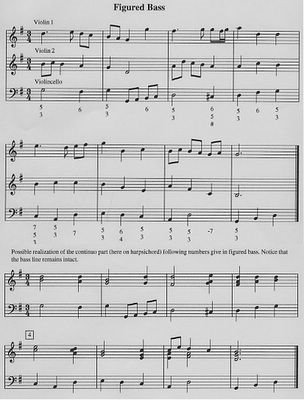New Ways to Notate Monody
Figured Bass, Thoroughbass, and Continuo
A new, shorthand notation evolved to indicate the chords, now reduced in function to filling in the texture between the important outside voices. The notation system was called figured bass or thoroughbass. The bass line was written in musical score but the notes of the chord were not. Instead, numbers were written below the bass note indicating the specific notes to be added by the lutenist or harpsichordist, and the player could place them where he pleased.
i>Continuo or basso continuo actually refers to the musical texture of the accompaniment. Here one must have both a chordal instrument playing the chords indicate by the figured bass and a bass instrument playing the notated line. The bass instrument was usually a violincello of a bassoon. The title "Sonata for Two Violins and Continuo" tells the reader that he will hear two violins, a harpsichord or lute playing chords, and a cello playing the bass melody.
The texture of two soprano instruments and basso continuo also illustrates the "trio sonata" texture pioneered by Arcangelo Corelli in the late seventeenth century. Note that the trio sonata texture requires four players, and the term shows clearly the diminution of overall importance of the chord fill. The figured bass notation did not remain long the exclusive property of opera. The monodic texture was quickly adopted for all genres of Baroque music except imitative fugues and motets, and suites written for solo lute or harpsichord.

Score for two soprano instruments, a bass instrument and a figured bass part for keyboard or lute.

<< Home